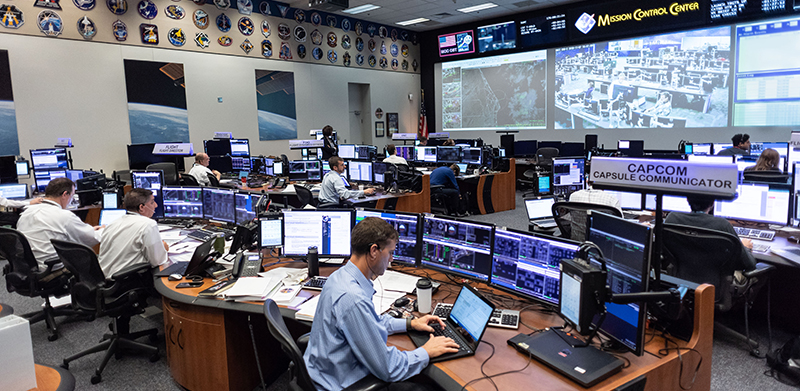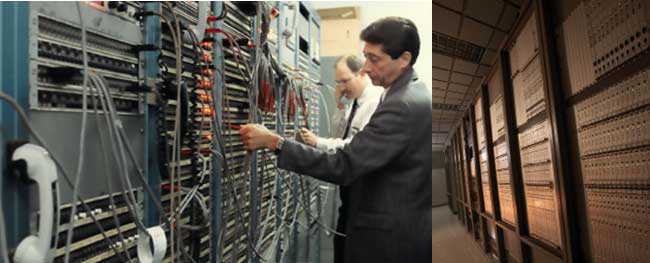
Mission Control Conference System Enables Global Collaboration
NASA Technology
Today conference calling is so easy and common it is essentially unremarkable. Share a toll-free phone number and instantly dozens, hundreds, or even thousands of people from anywhere on the globe can call in and talk to each other. Share a meeting link and, with a click, everyone can see video of other participants’ faces or a live view of their computer screen.
But behind the scenes, all of these simple operations take quite a bit of complicated technology—technology that didn’t exist before the 1980s, when NASA mission control decided to improve the system by which its engineers, technicians, and astronauts communicate. The spinoff benefits have rippled widely.
During any mission, information flows constantly, as technicians and engineers monitor a spacecraft’s fuel levels, the weather at the landing site, biometric readings from the astronauts, and more. As early as the Mercury missions in the late 1950s, the Agency built a complex system that managed to connect all the people on the ground and in space through a network of 18 ground stations and three ships in different oceans, with the central hub at Goddard Space Flight Center in Maryland.
But by the 1980s, NASA was ready for an upgrade. In particular, the Agency wanted a digital 4,000-port system that would instantly connect people within multiple, interchangeable groups across distant physical locations. The existing system allowed such networking, but it was cumbersome, explains Curt Suprock, now the chief of the NASA Communications (NASCOM) Division, based at Goddard.
“There would be these huge patch panels with all the cables pulling in, and that’s how you connected people,” by manually plugging and unplugging the cables to link different ports together, he explains. And if you wanted to connect a group of people on a single call, that required a different manual “conference ring” that was difficult to reconfigure once it was set up—it might even require ending the call and starting from scratch.
“We had an operation staff that knew intimately all the patches. With that team, you could do things very quickly. But you required that kind of expertise,” Suprock says. With improving computer technology, NASA saw the potential to automate the system to make it easier on the front and back end.
NASA hired a company called Compunetics to build two new digital systems for voice switching and voice distribution (VSS and VDS), which allowed voice connections and conference loops to be reconfigured instantly and automatically. Where before dozens of highly skilled technicians were racing to move cables between ports, now it could be done instantly with the push of a button.
The Compunetics systems were installed in 1992, and after extensive testing, NASCOM ultimately switched over entirely. The network has been updated since, and another update is in the works, Suprock says. But overall the change from analog to digital improved speed and flexibility, all while requiring far fewer people behind the scenes. Today NASCOM is still staffed around the clock, but instead of 40 or 50 technicians, it needs just 8.
Technology Transfer
Outside of NASA, phone companies would typically arrange the hardware to make a conference call happen. “You had to fax over a list of numbers to the AT&T operator, and they’d build up a conference,” explains Michael Hockenberry. First hired in the late 1980s as the NASA project was getting underway, he’s now a senior vice president of the Federal division of Compunetix, one of two companies that spun off from the original business.
With the new system it built for NASA, Compunetics knew it had something far better. Among other advances, the company had integrated its newly patented invention, a non-blocking switch, which meant that once a set of ports were hooked up, calls could be connected in any configuration within the network, even without contiguous connections. Although Compunetics founder Giorgio Coraluppi had actually invented this non-blocking algorithm prior to the NASA contract, Hockenberry explains, it took the NASA contract and funding for the company to figure out the market and develop the invention into a fully functional system.
That system “became the foundation for our communications systems division,” Hockenberry says, and the basis for the products and services the company offers to this day. The company based their commercial offering on the VSS system it had built for NASA and called it a conference bridge.
Next, Compunetics added a user-friendly operator interface that allowed an operator to add and drop parties from the conference by computer. Essentially, it changed conference calls from a manual task of connecting phone wires to contiguous ports, to a software function of linking different pieces of an interconnected network, which is the backbone of how conference calls still work today.
The Goddard contract “was really instrumental for us,” explains Robert Haley, communications director at Compunetics. “We took the technology from that large 4,000-port NASA system, and we really reconfigured it and commercialized it and took it directly to the commercial telecom market. We’ve never slowed down since then.”
Benefits
Today Compunetics actually comprises three companies, all based in Pittsburgh, and all of which trace back in different ways to the original innovations created for NASA. The original company, Compunetics, was founded in 1968 and today specializes in building small runs of complex printed circuit boards, including for the conference bridges but also for NASA’s Jet Propulsion Laboratory, the military, Intel, IBM, and other companies that need specialized circuit boards for specific projects.
The second company, Compunetix, spun off in 1990 as a separate entity to manufacture and sell the conference bridges first developed for NASA. Thanks to numerous updates along the way, Haley says, “we’re still the leading conference bridge manufacturer. We have millions of ports deployed worldwide.”
The third company, commercial conferencing agency Chorus Call, was created around the same time to help build the case for the Compunetix conference bridges, Haley explains. “If we were going to MCI and wanted them to buy our conference bridge, we wanted to prove to them we could build a business on that,” he says. “That small company created as a proof of concept is now a worldwide collaboration provider. We’re in 12 different countries right now.”
Among other modernizing updates along the way, an operator is no longer needed to add and drop callers from a particular conference. Compunetix built an automated system where the caller enters a passcode prompting the software to automatically drop him or her into the conference. The company has also added video conferencing capabilities in recent years.
Although there are many conference calling services available, to this day, when someone in an office dials into a conference call line, they are in many cases dialing into a Compunetix conference bridge. “Pretty much every large conference bureau around the globe uses us to some extent,” Haley says.
Even web-based video conference calling relies in part on Compunetix, Haley says. For example, the video connection may be through WebEx conferencing software, he explains, but for the audio, “you can connect with your phone or PC audio, or they can dial you back. That can be our switch doing that.”

NASA’s original communications network was a complicated analog system that required manually plugging and unplugging wires to link different ports (left). By the 1980s, the Agency was ready for a digital upgrade, and it turned to Compunetix to design and build a digital system that allowed voice connections and conference loops to be reconfigured instantly and automatically (right).

All crewed space missions are monitored at the Mission Control Center at Johnson Space Center. Behind the scenes, a vast communications network, based out of Goddard Space Flight Center, makes it all possible.













